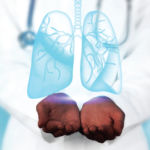 ORLANDO—Interstitial lung disease (ILD) affects many patients with rheumatic disease. And close collaboration with your local pulmonologist is vital to achieving the best outcomes for our patients. But what if you’re a pulmonologist and a rheumatologist at the same time?
ORLANDO—Interstitial lung disease (ILD) affects many patients with rheumatic disease. And close collaboration with your local pulmonologist is vital to achieving the best outcomes for our patients. But what if you’re a pulmonologist and a rheumatologist at the same time?
At the 2022 ACR Education Exchange, April 28–May 1, Erin Wilfong, MD, PhD, clinical instructor of rheumatology and pulmonary critical care, Vanderbilt University Medical Center, Nashville, shared her niche expertise in connective tissue disease ILD (CTD-ILD) via case-based learning.
Case 1
A 38-year-old woman presented for consideration of a lung transplant. She worked as an aluminum smelter and was not always compliant with personal protective equipment. On further questioning, she described Raynaud’s phenomenon of eight years’ duration that had been worsening in the past year, one year of progressive dyspnea requiring oxygen therapy and six months of new-onset acid reflux. On examination, she was found to have abnormal nailfold capillaries and digital pits. Her modified Rodnan skin score was 0. Chest computed tomography (CT) revealed groundglass opacities, but no traction bronchiectasis or honeycombing. Laboratory studies were notable for a strongly positive anti-ribonucleic acid polymerase III (anti-RNA pol III) antibody. She met ACR classification criteria for a diagnosis of systemic sclerosis sine scleroderma (ssSSc).
“I was asked to consider whether this patient should be evaluated for lung transplant or if she could receive a trial of immunosuppression,” Dr. Wilfong said. “The groundglass changes told me this was inflammatory, and in the absence of traction bronchiectasis or honeycombing to suggest fibrosis, there was a good chance she’d get better or at least stabilize with immunosuppression. This is especially relevant [because] average lung transplant survival is only five to seven years.”
The patient was treated with mycophenolate mofetil (MMF) with substantial improvement in six months. Her six-minute walk test nearly doubled, and her oxygen requirements decreased to only 2 L per minute with exertion, and none at rest.
For patients with SSc or myositis with high-risk autoantibodies for ILD, Dr. Wilfong recommends baseline complete pulmonary function tests (PFTs) and high-resolution CT (HRCT) of the chest.
“After that, I try to be judicious with radiation,” she said. “I’ll follow PFTs every three months at first, and space them out if they’re improving. I’ll re-image patients for a distinct clinical change [that’s much better or much worse]. If somebody gets way better, it’s helpful to have a new baseline scan for comparison in case they get worse again one day. I don’t routinely rescan stable patients.”


